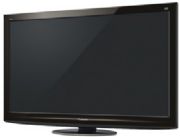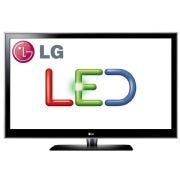HDTV Buying Guide: Select the Right Flat-Panel Technology
Before you drop hundreds or thousands of dollars on the wrong flat-panel HDTV set, read our comprehensive breakdown of everything you need to know. Our HDTV buying guide might just help you save some money.
You want to buy a new big-screen HDTV for your home. But where do you start? You have so many options, features, and specifications to choose from that it can be confusing. And since you're likely to keep this set for at least the next five years, you want to make a smart choice that you can live with for a long time.
High-definition television is truly different from the standard-definition television that it replaces. The screen is wider, and many more pixels make up the image, so you get greater detail. It's important to note that watching standard-definition TV on an HDTV won’t make standard-definition footage look any better. In fact, unless you adjust your HDTV to display standard broadcasts in their intended 4:3 aspect ratio (which fills only a portion of the screen), you’ll see a stretched-out picture that doesn’t look very good at all.
To get the most out of your HDTV set, you need the right content. That means you need to subscribe to your cable provider’s high-definition television shows and sports broadcasts, watch Blu-ray Discs, and stream HD movies via a set-top box or a TV with built-in Web connectivity.
For now, let’s focus on the TV set itself. In this HDTV buying guide, we'll break the process down into some simple steps that will help you pinpoint the best HDTV for your needs and budget.

In selecting a flat-panel screen, you must first choose between plasma and LED/LCD technology. You also need to determine what size to buy. HDTV sets are measured in terms of horizontal screen measurements; in other words, a “46-inch” HDTV has a screen measuring 46 inches diagonally. Before you head to the store, make sure the depth, height, and width of your TV’s setup area can accommodate your desired size. Also, make sure the TV stand or the wall you’d like to mount it on can handle the weight.
These days, practically every set measuring 40 inches or larger will have a resolution of 1920-by-1080 pixels, or 1080p. If you're buying a set with a screen that's 35 inches or smaller, you may find 720p models available. The difference is that the 1080p sets have more pixels that make up the image; they are thus capable of providing the highest detail possible. If you're viewing a smaller screen from a distance, however, you'll be too far to notice the added detail of a 1080p set, so in many cases 720p will be just fine for smaller TVs.

If you walk into an electronics store today, you’ll find two main types of HDTVs to choose from: LED and plasma.
First, a word about that “LED” moniker: This is not a new type of TV, despite what manufacturers and electronics stores would have you think. Instead, it's simply an LCD (liquid crystal display) panel that uses LEDs (light-emitting diodes) as its backlight system instead of the traditional fluorescent tubes. Whatever you want to call them, these sets use a bright backlight that shines through a layer of liquid crystals. The crystals move to let the backlight pass through or they block the backlight altogether.
Plasma sets, on the other hand, use an electrical charge to make a gas give off ultraviolet light, which in turn causes phosphors to glow—basically the same process that a typical fluorescent lamp uses. (For more on modern plasma vs. LED/LCD TVs, read Plasma vs. LCD: The State of HDTV.)
Other types of HDTV sets exist, but they're more rare. Rear-projection (DLP) TVs can offer incredible value—especially when you're looking at sizes of 60 inches or larger—but they're unpopular because they're bulkier than flat panels.
OLED (organic light-emitting diode) HDTV sets are at the other end of the thickness spectrum. There’s no backlighting system in an OLED set; each pixel is its own source of light and can be shut off completely. OLED sets are incredibly thin, display pictures with incredibly sharp contrast, and consume very little power. They’re also very expensive. The first generation of consumer OLED HDTVs was showcased at International CES 2012, and they’re likely to be more readily available in the coming years.
The widescreen format should fill more of your field of view, much as a movie theater screen does. As a result, the answer to the question "How big a screen do you need?" is probably "Bigger than you think." (For more about integrating your new HDTV with your home theater setup, see How to Install Your HDTV.)
If you decide that you can get by with an HDTV smaller than 42 inches, you're limited to buying an LED/LCD HDTV; plasma screens are not efficient to manufacture at sizes below 42 inches. If you're setting your sights on something larger, however, you have to choose between plasma and LED/LCD.
High-definition television is truly different from the standard-definition television that it replaces. The screen is wider, and many more pixels make up the image, so you get greater detail. It's important to note that watching standard-definition TV on an HDTV won’t make standard-definition footage look any better. In fact, unless you adjust your HDTV to display standard broadcasts in their intended 4:3 aspect ratio (which fills only a portion of the screen), you’ll see a stretched-out picture that doesn’t look very good at all.
To get the most out of your HDTV set, you need the right content. That means you need to subscribe to your cable provider’s high-definition television shows and sports broadcasts, watch Blu-ray Discs, and stream HD movies via a set-top box or a TV with built-in Web connectivity.
For now, let’s focus on the TV set itself. In this HDTV buying guide, we'll break the process down into some simple steps that will help you pinpoint the best HDTV for your needs and budget.
Size, Weight, and Resolution Basics

In selecting a flat-panel screen, you must first choose between plasma and LED/LCD technology. You also need to determine what size to buy. HDTV sets are measured in terms of horizontal screen measurements; in other words, a “46-inch” HDTV has a screen measuring 46 inches diagonally. Before you head to the store, make sure the depth, height, and width of your TV’s setup area can accommodate your desired size. Also, make sure the TV stand or the wall you’d like to mount it on can handle the weight.
These days, practically every set measuring 40 inches or larger will have a resolution of 1920-by-1080 pixels, or 1080p. If you're buying a set with a screen that's 35 inches or smaller, you may find 720p models available. The difference is that the 1080p sets have more pixels that make up the image; they are thus capable of providing the highest detail possible. If you're viewing a smaller screen from a distance, however, you'll be too far to notice the added detail of a 1080p set, so in many cases 720p will be just fine for smaller TVs.
Flat-Panel HDTV Technologies

If you walk into an electronics store today, you’ll find two main types of HDTVs to choose from: LED and plasma.
First, a word about that “LED” moniker: This is not a new type of TV, despite what manufacturers and electronics stores would have you think. Instead, it's simply an LCD (liquid crystal display) panel that uses LEDs (light-emitting diodes) as its backlight system instead of the traditional fluorescent tubes. Whatever you want to call them, these sets use a bright backlight that shines through a layer of liquid crystals. The crystals move to let the backlight pass through or they block the backlight altogether.
Plasma sets, on the other hand, use an electrical charge to make a gas give off ultraviolet light, which in turn causes phosphors to glow—basically the same process that a typical fluorescent lamp uses. (For more on modern plasma vs. LED/LCD TVs, read Plasma vs. LCD: The State of HDTV.)
Other types of HDTV sets exist, but they're more rare. Rear-projection (DLP) TVs can offer incredible value—especially when you're looking at sizes of 60 inches or larger—but they're unpopular because they're bulkier than flat panels.
OLED (organic light-emitting diode) HDTV sets are at the other end of the thickness spectrum. There’s no backlighting system in an OLED set; each pixel is its own source of light and can be shut off completely. OLED sets are incredibly thin, display pictures with incredibly sharp contrast, and consume very little power. They’re also very expensive. The first generation of consumer OLED HDTVs was showcased at International CES 2012, and they’re likely to be more readily available in the coming years.
Selecting the Right HDTV Size
All HDTVs are wide format, which means that their proportion resembles that of a movie screen more than that of a traditional, standard-definition TV screen. In technical terms, the widescreen aspect ratio is 16:9—for every 16 units of width, the screen is 9 units tall—while standard-definition screens have a 4:3 aspect ratio.The widescreen format should fill more of your field of view, much as a movie theater screen does. As a result, the answer to the question "How big a screen do you need?" is probably "Bigger than you think." (For more about integrating your new HDTV with your home theater setup, see How to Install Your HDTV.)
If you decide that you can get by with an HDTV smaller than 42 inches, you're limited to buying an LED/LCD HDTV; plasma screens are not efficient to manufacture at sizes below 42 inches. If you're setting your sights on something larger, however, you have to choose between plasma and LED/LCD.
--------------------------------------------------------
always chooose the famous brand with lots of service centres around.
